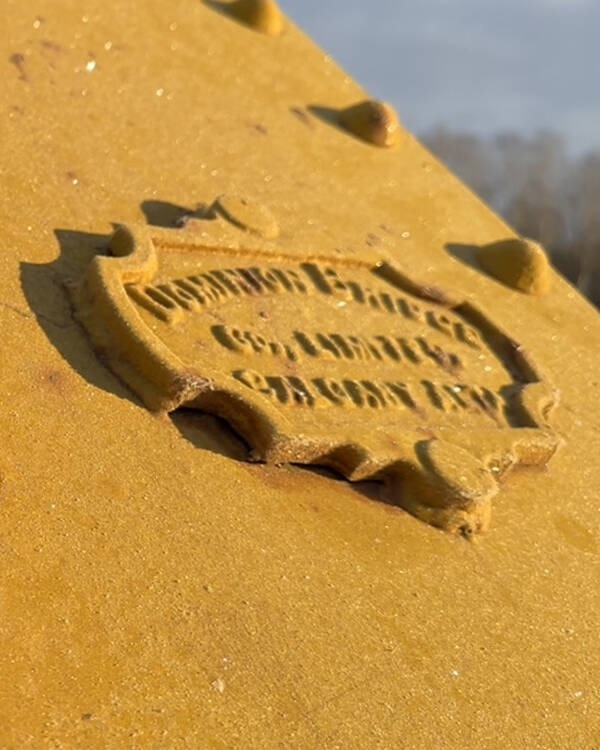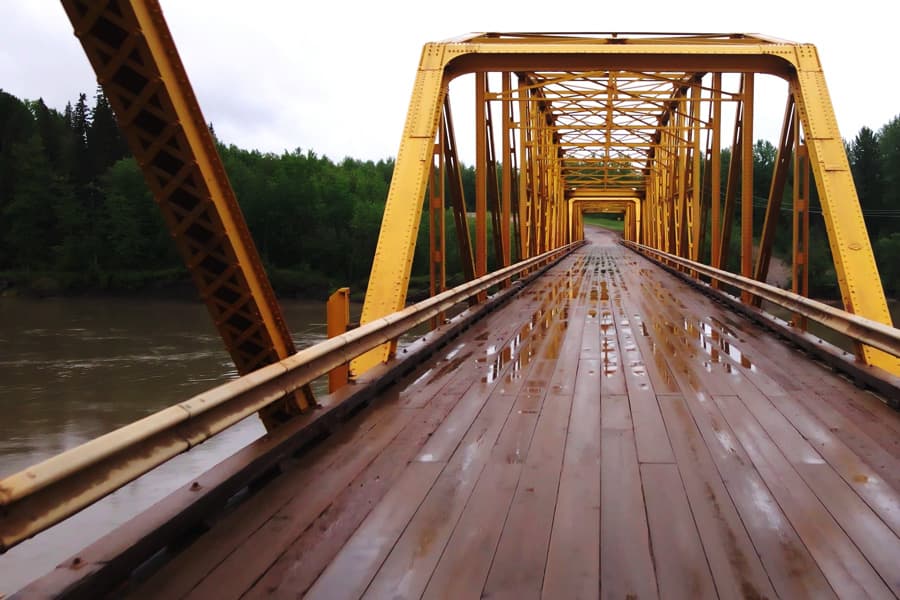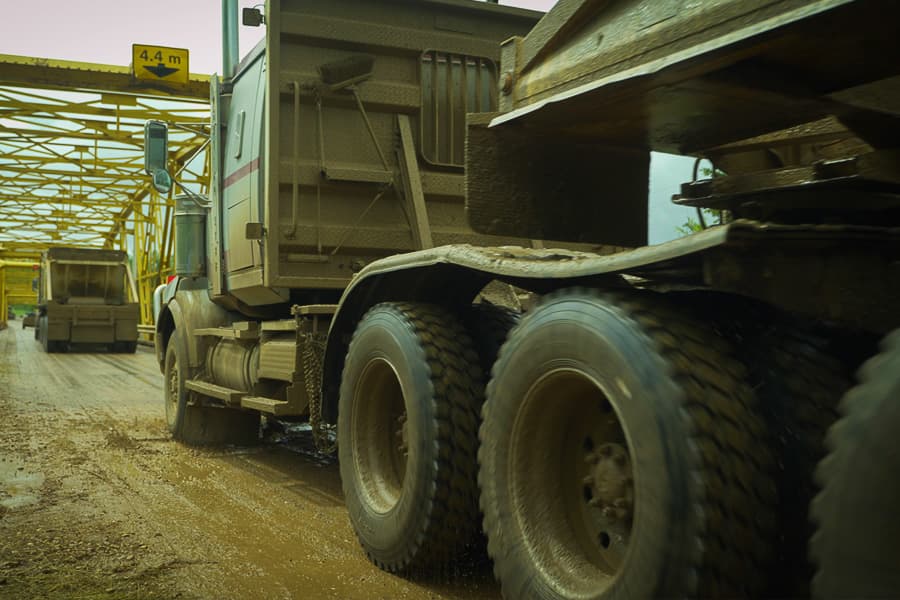what we need
We seek to secure project funding that is commensurate with the importance of the Smith Bridge to the province’s bottom line.
Proportionate funding
Establishing a project co-funding formula that considers the contributions of regional industrial output rather than the present unworkable 75/25 split.
Stakeholder commitment
Endorsing a commitment to the timelines and respective cost obligations for the Smith Bridge construction phase.
Alternate funding solutions
Possible ministerial order; backing capabilities; borrowing; and /or staged progress payments.

The Smith Bridge is a vital part of the MD’s transportation network, but it is rapidly deteriorating. Originally designed by the US Army Corps of Engineers with a service life expectancy until 2022, the bridge faces challenges due to increased industrial traffic that heavily — and increasingly — relies on it.
Provincial funding for this project would eliminate a major barrier to industrial expansion and continued economic stability in the region. Pre-engineering studies estimate replacement costs at $68 million. The standard STIP condition is that the MD would absorb 25% of this cost ($17 million). This is not a fiscally responsible equation for any rural municipality.
After three decades of lobbying, the MD has secured the required provincial funding to embark upon the replacement of an essential yet end-of-life bailey bridge over the Athabasca River in the Hamlet of Smith. Our provincial partners grasp the strategic importance of the Smith Bridge and Highway 2A corridor in connecting several key sectors to global markets. Accordingly, Council is eager to engage decision-makers in a dialogue on maintaining the momentum of this critical venture.
In 2023, the Province underwrote a STIP investment of $1,652,850 representing three quarters of the preliminary engineering, design and permitting and site selection study costs of this project.
A separate STIP application for $2,000,000 was approved in 2024 to leverage the design and subsequent project cost estimates for replacement of this vital corridor.
To date, the Province has invested a total of $3,652,850 into this project, and the MD has invested and/or committed to $2,568,573 since 2020.
Working with Minister Dreeshen and our provincial partners, we have secured the necessary funding contributions for the replacement process studies of the bridge structure and completed essential pre-planning and design work. We are sincerely grateful to Minister Dreeshen and his ministry team for the leadership role they have played in achieving these milestones. We look forward to their continued commitment to this project as it moves to the next phase.
With the preliminary and detailed design phases either complete or in process, we are now focused on getting this bridge built. Construction is scheduled to be tendered in 2026, with work commencing in 2026 and concluding by 2027. This timeline hinges on the continued financial backing of the Province, coupled with the MD’s ability to sustainably meet its own obligations.
Council is hopeful that, by negotiating — and committing to — a workable funding formula and/or process, all parties will be better equipped to plan; uphold accountabilities; and ensure resource allocations align with fiscal and temporal constraints.
A Binding and Proportionate Commitment
Pre-engineering studies estimate replacement costs at $88 million. The present STIP formula dictates that the MD would absorb 25% of this cost ($22 million). This is simply a non-starter for a rural municipality with a residential tax base of just 2,800. It would place disproportionate pressure on the MD to reallocate revenue from other operational areas to meet this obligation — at the cost of other infrastructure maintenance and replacement priorities.
Our position is that all options should be on the negotiating table, from staggering provincial funding over several years to reducing the MD’s cost obligation. In this spirit, Council urges Minister Dreeshen to view this matter under a different lens.
The Smith Bridge is integral to supporting key industrial sectors that drive Alberta’s economy. Lesser Slave River is home to the most lucrative heavy oil play in North America, in addition to one of the most profitable and sustained forestry plays in the world. Our key forestry producers Tolko, West Fraser and Vanderwell paid the Province over $157 million in stumpage fees over the past five years. Oil & gas royalties are harder to calculate by region; however, oil production in the Lesser Slave River region ranked fifth in the province last year, yielding approximately five million cubic meters. Given that oil & gas provides more than a quarter of Alberta’s annual revenue, the contribution of our producers to Alberta’s bottom line is significant.
Heavy industry in our municipality injects hundreds of millions of dollars in taxes, stumpage fees and royalties into the provincial coffers each year. One could argue that these producers help fund many critical infrastructure projects across Alberta each year. The absence of these provincial revenues would certainly be felt with even a moderate reduction in output.
By these measures, the Smith Bridge rebuild project merits consideration as a special case for provincial grant funding. If undertaken now, this would represent an investment in significant cost savings, risk reduction and economic growth — both at the local and province-wide level over the long term. By working with the Province to arrive at a fair and proportionate funding arrangement, we can safeguard a critical linchpin in our economic corridor and ensure the sustained output of our heavy industry producers.
“We seek a stable financial foundation for the Smith Bridge construction phase. This will help ensure the accountability of all stakeholders, including municipal leaders, government partners, industry stakeholders, and the community at large.”
-Reeve Murray Kerik
The Smith Bridge plays a pivotal role in connecting regional heavy industry to the global marketplace. It bears increasingly heavy industry use, yet its days are numbered. Let’s continue to make this project a priority. In doing so, we will maintain economic stability, accommodate essential industrial thoroughfare, and sustain our region’s hefty contribution to Alberta’s bottom line.

MAIN COUNCIL OBJECTIVE
Council requests that the Province enter into negotiations with the MD to consider different financing scenarios and establish cost obligations to begin construction on the Smith Bridge. Discussions should include provisions for:
- Proportionate funding: Establishing a project co-funding formula that considers the contributions of regional industrial output rather than the present unworkable 75/25 split.
- Stakeholder commitment: Endorsing a commitment to the timelines and respective cost obligations for the Smith Bridge construction phase.
- Alternate funding solutions: Possible ministerial order; backing capabilities; borrowing; and /or staged progress payments.
SUPPLEMENTAL COUNCIL OBJECTIVE
Council seeks guidance from Minister Dreeshen on leveraging the LMI stream and other funding programs, formulas (and respective ministries) relevant to our stated infrastructure needs.
The Smith Bridge is five years past its engineered life span. The time to rebuild is now, and we need the Province to prioritize the required funding.
The background information on this initiative will be updated following the Rural Municipalities of Alberta 2023 Fall Convention (November 6 – 9, 2023). Thank you for your patience.


The Smith Bridge is five years past its engineered life span. The time to rebuild is now, and we need the Province to prioritize the required funding.
The Smith Bridge is located on the north side of the Hamlet of Smith crossing the Athabasca River. Built in 1944 and finished in 1945, the structure is approximately 228m long, 5.5m wide, and a vertical height of 4.7m. Historical issues include sloughing of the north abutment; erosion gullies on both abutments; and horizontal cross brace damage due to oversized load collisions. Recent inspections, including a 2021 scour survey, have found significant deterioration of pier 3. The current alignment makes this pier extremely susceptible to debris accumulations, requiring near-constant monitoring and periodic debris removal at the expense of the MD.
In early 2016, the Clearwater Oil Formation was discovered in the Marten Hills region of the MD. Highway 2A via the Smith Bridge provides one of the easiest access points to Clearwater — currently the most productive and lucrative heavy oil play in North America. In addition to the MD’s robust oil & gas sector, there is a significant forestry industry thriving in the Lesser Slave River region. The Government of Alberta benefits from royalties and stumpage fees to the tune of hundreds of millions of dollars each year.
The Smith Bridge reached the end of its service life in 2022; however, in January of 2022 the Alberta Government extended its life to 2034. Estimated replacement costs for a two-lane open-top bridge, plus the required repairs to the alignment and north slope, range from $70 to $100 million. Provincial funding for this project would eliminate a major barrier to industrial expansion and continued economic stability in the region. The bridge needs $553,000 IN URGENT REPAIRS in order to remain operational for an additional 4 to 5 years.
In November of 2022, the MD submitted two STIP grant applications to the provincial government. The first application was to fund urgent repairs necessary to maintain the operation of the Smith Bridge, while the second application was to initiate the design process for replacing the bridge.
PRIMARY CONCERNS
- This is a major bridge located on a road that services residents, tourists and the travelling public — but it is also heavily utilized by the oil & gas and forestry industries. The traffic needs of today are significantly different from those of 1944, and it is not feasible to expect a bridge from that era to meet the current economic demands.
- The narrow bridge deck width and restricted height due to the overhead structure prevent the bulk of industry vehicles and equipment from using the Smith Bridge to access their sites in the north of the MD.
- The bridge’s outdated design limits the size of agricultural equipment that can cross, which results in agricultural producers taking a 60km detour to access their properties.
SUPPORTING DATA
A tenuous link in a vital economic corridor
HUNDREDS OF MILLIONS IN ANNUAL ROYALTY AND STUMPAGE DOLLARS HINGE ON THE INTEGRITY OF THE SMITH BRIDGE

invest in albertans
This war-era bridge was slated for replacement in 2019.
When the Smith Bridge was built, it was estimated that it would provide 75 years of useful service — beyond which point it would need to be replaced. According to its original builders, 2019 was the bridge’s end-of-life date.
resource revenues
Fixing this link in our transportation corridor benefits every Albertan.
An uncovered two-lane bridge would provide industry with greater opportunities for exploration; a more reliable sales route; and numerous other benefits.
An ideal window of opportunity exists for the MD’s thriving industrial plays to help offset the costs to replace this bridge. However, this opportunity will not exist forever.

30
Years of lobbying
The MD’s advocacy for the Smith Bridge rebuild go back 30 years or more. Councillors broach the subject in practically every meeting with the Province.
80
Years of service
When the Smith Bridge was built during WWII, it was engineered to provide 75 years of useful service — after which it would need to be replaced. 2019 was its expiry date.
622
Active well licences along Highway 88
Industrial use of Highway 88 will increase in tandem with thriving timber and oil & gas operations in our region.
Leadership
Industry leaders and community members are helping the MD convey the Smith Bridge value proposition to the Province.
“Getting this bridge rebuilt in the near term is our foremost strategic priority as Councillors. The Province is well aware of our concerns, and I remain hopeful that our lobbying efforts will bear fruit.”
Lesser Slave River Reeve Murray Kerik


